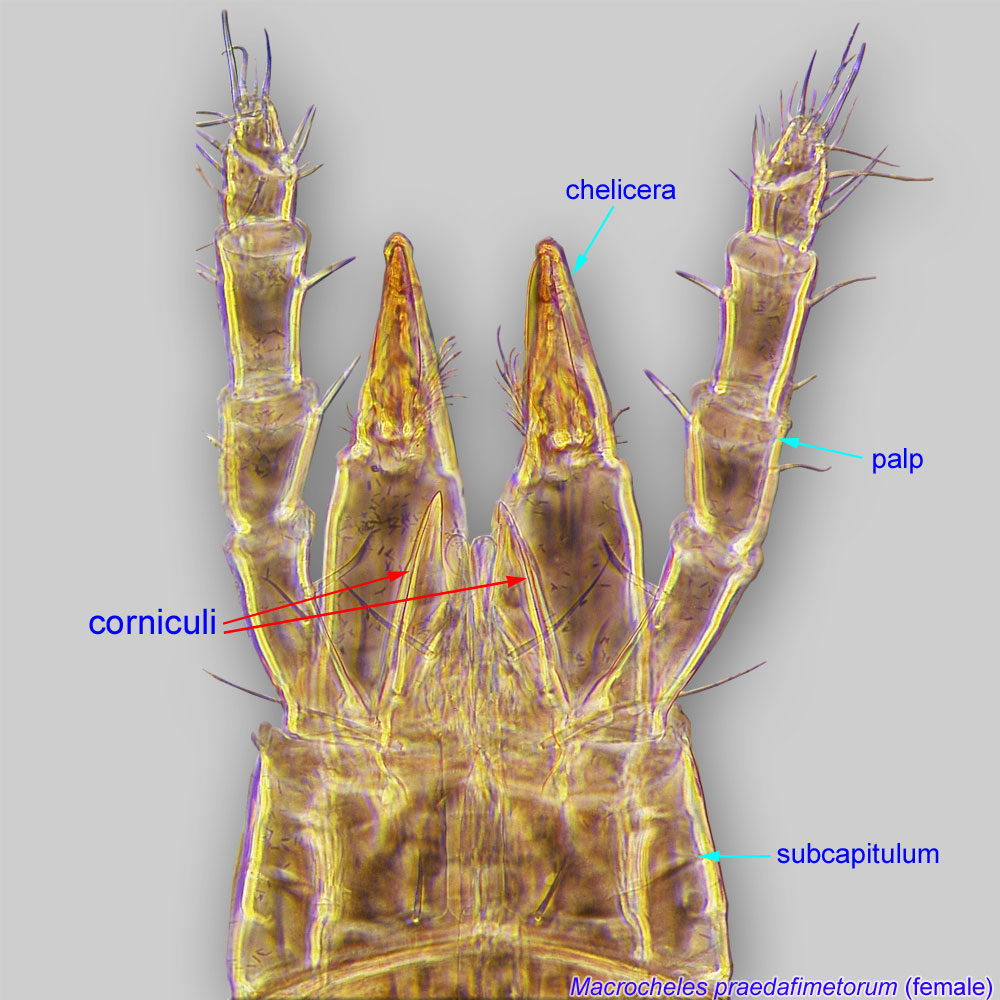possibly kleptoparasitic; may consume provisioned pollen in nest
Hattena Domrow, 1963
Superorder Parasitiformes » Order Mesostigmata » Suborder Monogynaspida » Hyporder Dermanyssiae » Family Ameroseiidae » Genus Hattena
Hattena erosa Domrow, 1963
Edbarellus Manson, 1974
Female: Dorsal shield not rugose, without large ridges (Figs. 1, 3; compare with Ameroseius where it is rugose), with less than 25 pairs of setae (Figs. 1, 3). Setae j1 simplesimple:
Of claws or setae; not modified or not bi- or trifurcate at tip.
, filiform, setae J5 absent (Fig. 3). CorniculiCorniculus:
Paired, horn-like process (sometimes toothed, bifurcate, trifurcate, spine-like, spatulate, or membranous) on the subcapitulum of parasitiform mites. These processes usually support the salivary styli. If toothed could be confused with a rutellum, a possibly homologous structure in Acariformes and Opilioacarida.
 undivided (or divided), surrounded by transparent membrane (Fig. 8). All legs with well developed ambulacrumambulacrum:
undivided (or divided), surrounded by transparent membrane (Fig. 8). All legs with well developed ambulacrumambulacrum:
The claws and empodium of the apotele or pretarsus.
, claws reduced (Fig. 12). Spermathecal ducts (rami) not fused (Fig. 15).
A dichotomous key is available in Faraji and Cornejo, 2006Faraji and Cornejo, 2006:
Faraji, F. amp; X. Cornejo. 2006. A new Hattena Domrow (Acari: Ameroseiidae) from Ecuadorian mangroves and a new generic record for South America. International Journal of Acarology.32: 287-291., but Hattena dalyi (Elsen, 1974) comb. nov. (from Afrocypholaelaps) is omitted.
Similar to Afrocypholaelaps. Can be distinguished by the presence of fewer than 25 pairs of setae on its dorsal shield (29 pairs in Afrocypholaelaps) and by its separate spermathecal rami (fused in Afrocypholaelaps).
Known from the tropics of the Old and New Worlds (Ecuador, Kenya, Taiwan, Australia, and south-east Asia). Has been found on bees only in the Old World.
Bee records include the European honey bee Apis mellifera, an unidentified bee, and the small carpenter bee Ceratina subquadrata.
facultativefacultative:
can complete entire life cycle without bees or their close relative, wasps
Three species are known from bees: Hattena dalyi (Elsen, 1974), Hattena ewae (Haitlinger, 1987), and Hattena tonganus (Manson, 1974). Although there is no host specificity to a particular animal carrier, some host plant specificity may exist. For example, in Australia, Hattena incisa occurs only in the flowers of the stilted mangrove, Rhizophora stylosa, while Hattena panopla occurs in the flowers of a range of plants, but not those of R. stylosa (Halliday, 1997Halliday, 1997:
Halliday, R. B. 1997. Revision of the Australian Ameroseiidae (Acarina: Mesostigmata). Invertebrate Taxonomy.11: 179-201.).